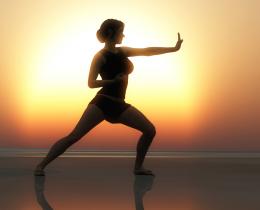Omega: Can you talk about the different types of qigong and how someone new to the practice might find the right one for them?
Roger: The best way to get started is to expose yourself to as many teachers as possible. Read books. Go to YouTube. If there are 10,000 different ways to do these practices, as Chinese scholars say, are you really going to do just one? The answer, of course, is no. The only way to make your way is to observe many people doing these practices in as many ways as possible so you are empowered with the understanding that there are many ways to practice, not just one.
A good way to get into tai chi or qigong is to find a beginner level program. There are many complex forms of these practices, but when starting out I encourage people to find an easier entry point. At the Institute of Integral Qigong and Tai Chi, we’ve developed Tai Chi Easy™—there are also other programs out there that simplify practice for the beginner.
Omega: Is there a best time and place for practicing tai chi or qigong?
Roger: The Chinese say to do your practice first and build the rest of your life around it, which I think is a very powerful insight. I tend to practice in the morning before I do other stuff, but many people can't do it that way. I encourage people to do their practice whenever they can, for as long as they can, and in whatever location that they can. People are often looking for somebody else to tell them what to do, as if there's one perfect way. Trust yourself, keep experimenting, and find what works for you.
Omega: How has your personal practice evolved throughout the years?
Roger: My first exposure to these kinds of practices was with yoga. I used to skip school and watch Lilias Folan on her public television show, Lilias Yoga and You. I was originally initiated in transcendental meditation in 1963. Like many others, I have arrived at the conclusion that the most important practice is the practice that I like to do and feel comfortable doing. My practice has transitioned constantly since 1963. Right now I’m focusing on refining my meditation practice in an interesting way. In tai chi and qigong, the meditation is in motion. I do sitting meditation as well, and just keep refining it. I’m moving up from what we might call the personal vantage point to a more transcendental vantage point.
Omega: How do you achieve balance and harmony in your own life?
Roger: Balance and harmony in Chinese medicine and Chinese philosophy are represented by the yin-yang symbol. The name for that symbol in China is tai chi. When we say the word tai chi, we usually think of exercise or meditation. But, in Chinese, the word tai chi means the balance and harmony of the forces of the universe.
For myself, I try to have balance and harmony in my rest and activity. I try to have balance and harmony in my work and the periods between my work. In my nourishment, I have a balanced amount of eating and not eating. And even what I eat, I want to have a balance of the proper nutrients for me. People have so many different metabolic constitutions. The metabolic constitution for some people is strong toward the need for protein and that same need is not present in others. So I have discovered what works best for me. Similarly, I want to have a balance between my mental focus in work and my mental focus in spiritual cultivation and entertainment. Entertainment is not a distraction. It’s something else. Feeding the imagination and taking a little rest from business is important, and I periodically ask myself how am I doing on this aspect of life, too.
Omega: Are there any misconceptions about Chinese medicine that you would like to demystify?
Roger: We tend to romanticize these ancient systems. They have been through thousands of iterations from their inception until now, which gives us a multitude of approaches. In Chinese medicine, we have the yin-yang approach, the three treasures approach, and the five elements approach. People argue about which one is better. To me, they’re just three different equally profound views.
The many approaches can be confusing because they create a variety of options over time. And, sometimes political and cultural forces cause an evolution of ideas. Not every new idea is an improvement. For example, Chinese medicine after the Cultural Revolution is very different than Chinese medicine before the Cultural Revolution. It’s really hard to tell if the new version is better or not. Both are effective.
To make rich ideas—and practices—useful, teachers, leaders, and experts must encourage learners to trust themselves and their own observations. Everything else is an opinion. Even our own version of how things work is an opinion, but at least it’s an opinion based on our own experience. Believing the experts know what we "should" do is so much less powerful than trusting our own experiences. I personally believe mind-body practice and integrative medicine should focus on helping people to feel empowered to observe themselves and trust their experience, as opposed to asking others about how they should live, what they should do, and how they should do it.
Omega: Are there similar misunderstandings about tai chi and qigong?
Roger: When someone says that you should do a practice a certain way, all I can think is, "How do you know that?" Every practitioner is different in visible and invisible ways. The only way to trust ourselves is to believe that it’s reasonable to pay attention to the experience that we’re having, as opposed to having someone else tell us what to think or do.



